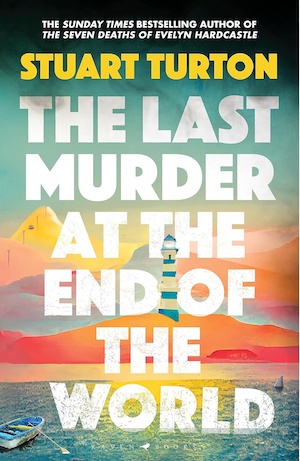A new Stuart Turton novel is always met with great anticipation and high expectations. The author, who frequently draws inspiration from Golden Age crime fiction, is undoubtedly skilled at crafting original mysteries. In his latest high-concept thriller he creates an entirely fictitious and post-apocalyptic setting on a remote Greek island.
Here, 122 villagers and three scientists, also known as elders, appear to coexist in harmony. The villagers fish and farm, obey the elders and follow a strict nighttime curfew. There is no violence or crime, everyone works together and the villagers live to serve. From birth, they are taught that the elders are wise and should never be questioned.
The elders are also the villagers’ last connection to the old world; without their knowledge, the people would not survive – or so they are led to believe. If this sounds like a typical cult set-up to you, don’t worry, this is more than just a one-way trip to the Kool-Aid stand.
The island is all that is left of humanity. Ninety years ago, a fog containing millions of glowing insects swept the planet, swallowing entire cities and their inhabitants. Out of the 117 individuals who once worked for the groundbreaking Blackheath Institute, the scientists are the only three that remain. The Institute built the barrier that keeps the fog out of the village, but it has since been completely sealed off while still containing all the equipment and experiments. The truth is equally concealed and inaccessible.
Niema was the lead scientist at Blackheath. She is now the most adored elder, a teacher who imparts her vast knowledge to the village children, and a pillar of the community. Everyone trusts Niema, and why wouldn’t they?
That is, until Niema is found dead in the warehouse, seemingly from a beam crushing her skull. There is also evidence of a fire, but no one knows what happened because everyone in the village was fast asleep under the curfew. However, they have no recollection of the previous evening, despite evidence that there was some sort of celebration.
Emory is the only villager who dares to ask questions, much to the chagrin of the rest of the community, including her daughter and father. Her determination to find answers and unquenchable thirst for the truth make her the ideal investigator. She becomes Turton’s Poirot in this modernised and revised closed circle Agatha Christie-style mystery. Was Niema killed by a blow to the head or by accident?
If having a murderer at large isn’t enough, Niema’s death triggered the deactivation of the system that keeps the killer fog away from the village. Emory has 91 hours to solve the murder before the island will be engulfed in fog. If she successfully identifies the killer the barrier will be reactivated. With the fog closing in and all of the witnesses (murderer included) suffering from memory loss, Emory has her work cut out for her.
Was Niema really the compassionate, wise older woman everyone believed her to be or did she have self-serving motives? Niema was planning an experiment before she died, one which could have been catastrophic if it failed. Apart from its post-apocalyptic theme, the novel has a West World feel to it. Was Niema the mother of this secluded civilisation or was she a Dr Frankenstein? Maybe a little bit of both. Even after her death she continues to control.
Abi functions as an omnipotent narrator as well as an AI with communal consciousness. Villagers are born with Abi, an inner voice that can listen to their thoughts and guide them through life. As Abi herself points out: “The great benefit of being in somebody’s head since birth is that your voice is easily confused with their own.”
Unfortunately, this affects the reader as well. Sometimes, this body-less inner voice can be confusing because readers have to discern between Abi’s voice and those of the characters. It puts a daring spin on the unreliable narrator trope. Can Abi be trusted? Does she help or hinder?
What The Last Murder at the End of the World makes abundantly clear is the probable future of humanity if we remain apathetic about its current state. Despite its experimental tone, it gives a chilling glimpse into an unsettlingly plausible future. And this is far more terrifying than a human-consuming fog, an amnesiac murderer, cannibalistic flowers, or a memory-extracting machine.
Turton admitts that he is a sucker for novels that defy expectations and blend multiple genres together. The key to keeping a genre new and engaging for readers is to experiment, for example, by taking an established trope and giving it a surprising new spin. The question is, how experimental can you be without alienating your reader? He has balanced on a knife’s edge for three novels so far, each one combining genres, dishing up the unexpected. It’s a risky move that will appeal to some while distancing others.
The Last Murder at the End of the World had me in two minds. I admired Turton’s daring experiment, but it ultimately left me disorientated and maybe even a little bit weary. Readers will need dedication to persist and keep up with the entangling plot twists. Had it been 100 pages shorter with fewer plot lines, it would have packed a bigger punch, allowing its innovative style to shine through. To use Emory’s words: “It’s like trying to assemble a jigsaw puzzle by throwing pieces at the floor.” Though, to be honest, I felt similarly about The Seven Deaths of Evelyn Hardcastle, so perhaps I’m less adventurous than I thought.
Also see our review of The Seven Deaths of Evelyn Hardcastle.
Raven Books
Print/Kindle/iBook
£10.99
CFL Rating: 3 Stars
